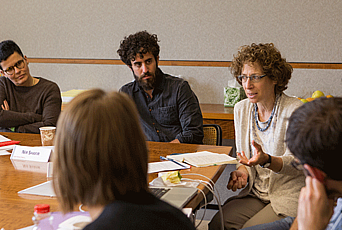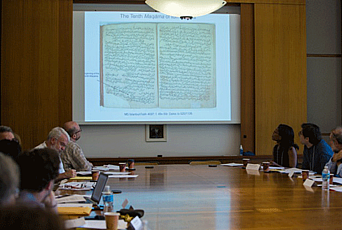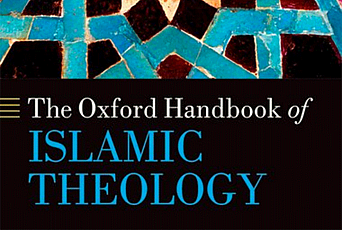The Zaydi Manuscript Tradition
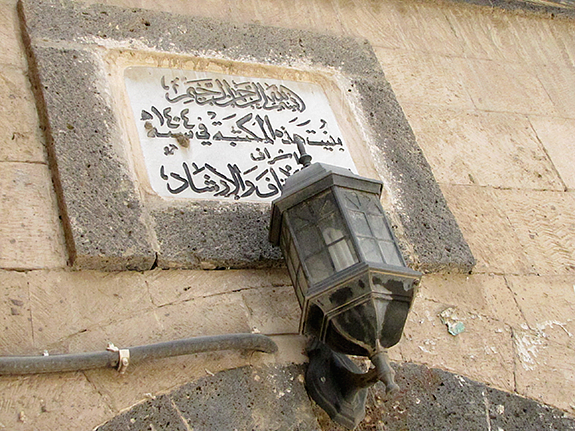
Reducing the intellectually rich and diverse Islamic literary heritage to a bare minimum of what is seen as allegedly authentic is a strategy that is characteristic of Wahhabism, Salafism, and jihadism and their respective proponents. Whatever goes against their interpretation of Islam is classified as "heretical" and banned from distribution. Moreover, libraries holding books and manuscripts that are seen as containing deviant views are targeted for destruction, as is also the case with historic monuments, shrines, and religious sites, which have been destroyed over the past decades by Muslim extremists in an attempt to allegedly "purge" Islam.
Mention should be made of the attempts by Islamic militants to destroy the important manuscript holdings in Timbuktu in 2013,1 or the destruction of books and manuscripts in the libraries of Mosul at the hand of ISIS in 2015.2 Another example has received less public attention, though the significance of the literary material and the level of destruction go far beyond the case of the Timbuktu or the Mosul collections. It concerns the Zaydi Manuscript Tradition, which is primarily preserved in the numerous private and public libraries of Yemen. Many manuscript collections have been severely damaged, looted, or even destroyed over the past decade, and the continuing war in the country, with its daily bombardments, constitutes an imminent threat not only to the local population, but also to the cultural heritage of the country, including its many libraries.3
To be sure, the world heritage of Islamic manuscripts in its entirety is an extraordinarily rich one and the extant Islamic literary tradition of the premodern period surpasses by far what is preserved, for example, in Latin and Greek. The three most renowned digital collections of classical Arabic texts, al-Jāmiʿ al-kabīr, Shamela.ws, and ShiaOnlineLibrary.com, include at present about 7,895 individual titles, circa 1.1 billion words in total.4 Not included in any of these counts are printed Arabic materials that are not available in digital form. Moreover, the manuscript tradition continued longer in the Islamic world than anywhere else, and only a fraction of the Islamic literary heritage is available by now in print. Preserving this vulnerable heritage and making it accessible to a wider audience is therefore of imminent significance.
The Zaydi Manuscript Tradition: An endangered cultural heritage
The Zaydi community is a branch of Shii Islam that has flourished mainly in two regions, namely the mountainous Northern Highlands of Yemen and the Caspian regions of Northern Iran. The two Zaydi states that were established in the ninth century C.E. initially constituted separate political and cultural entities. The situation changed in the early twelfth century, when a rapprochement between the two communities began that eventually resulted in their political unification. The political development was accompanied by a transfer of knowledge from Northern Iran to Yemen that comprised nearly the entire literary and religious legacy of Caspian Zaydism.
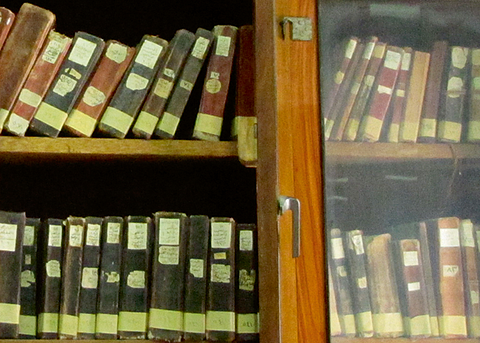
During the reign of Imam al-Manṣūr bi-llāh ʿAbd Allāh b. Ḥamza (r. 1197–1217), the knowledge transfer to Yemen reached its peak. The Imam founded a library in Ẓafār, his town of residence, for which he had a wealth of textual sources copied by a team of scholars and scribes. More than seven hundred years later, in 1929, the rich holdings of his library, which had continued to grow under his successors, were transferred from Ẓafār to the newly founded al-Khizāna al-Mutawakkiliyya (now al-Maktaba al-Sharqiyya or Maktabat al-Awqāf), which is housed in the complex of the Great Mosque of Ṣanʿāʾ.
The Zaydi literary tradition is among the richest and most variegated strands within Islamic civilization, and at the same time one of the least studied. The literary production by Zaydi scholars stretches over more than a thousand years covering a wide spectrum of traditional disciplines. Moreover, Zaydis were at all times intimately familiar with the relevant intellectual strands beyond the confines of their own community, and they actively engaged in them. The typical library of a Zaydi scholar would comprise not only works belonging to his own religious tradition, but also an array of titles of authors from other communities, including the literary legacy of the Muʿtazila, one of the most important rational schools in the history of Muslim theology. The Yemeni manuscript collections thus constitute a unique treasure trove for large segments of the Islamic intellectual tradition—Sunni as well as Shii—much of which has not survived anywhere else in the Islamic world.
It is fortunate that the majority of Zaydi literature is still extant, mostly in the form of manuscripts. On the downside, the Zaydi manuscript tradition is widely dispersed. The most significant and by far largest collections of Zaydi manuscripts are housed by the many public and private libraries of Yemen (estimates of their holdings range between 40,000 to 100,000 manuscripts). In addition to this, several European libraries own considerable numbers of Zaydi manuscripts (about 10,000 manuscripts), as is also the case with North American libraries (fewer than 1,000 manuscripts). Of great importance are also the many libraries of the Middle East, especially in Egypt, Saudi Arabia, Turkey, Iran, and Iraq, and other places with significant numbers of Zaydi manuscripts.
In view of the poor state of scholarship in the area of Zaydi studies, the challenges that result from the dispersal of the material, and the disastrous situation in present-day Yemen, the tasks at hand are threefold, namely "preserving" and "studying" the Zaydi manuscript tradition, as well as "democratizing" access to these materials.
The scholarly discovery of Zaydism
As a result of the geographical isolation of Yemen, the scholarly exploration of its political and intellectual history and of its rich manuscript holdings started later than was the case with most other parts of the Islamic world. Toward the end of the nineteenth century, a number of European explorers and merchants sojourned to Yemen where they brought together considerable collections of manuscripts that they later sold to European libraries. Mention should be made of the Austrian Eduard Glaser (1855–1908) who visited Yemen on four occasions between 1882 and 1894 and sold his nearly nine hundred manuscripts to the Königliche Bibliothek zu Berlin (now Staatsbibliothek zu Berlin), the British Museum in London, and the Austrian National Library in Vienna. The most significant collection of Yemeni manuscripts outside of Yemen (ca. 1,700 manuscripts) was purchased betwen 1906 and 1914 by the Biblioteca Ambrosiana in Milan. Important collections of Zaydi manuscripts from Yemen are also owned by Leiden University Library, the Bavarian State Library in Munich, the Biblioteca Apostolica Vaticana, Princeton University Library, and Yale University Library.
On the basis of the European collections of Yemeni manuscripts, it was mostly German and Italian Arabists who initiated the scholarly investigation of Zaydism during the early decades of the twentieth century. The German scholar Rudolf Strothmann (1877–1960) began to study the holdings of the Berlin Glaser collections during a visit to the city in October 1908, and his rich scholarly output on Zaydism (published between 1910 and 1923) laid the foundation for what was then an entirely new field of study. Dutch scholars were also engaged in Zaydi studies, as were Italian Arabists, who had the largest collection of Yemeni manuscripts at their disposal: Eugenio Griffini (1878–1925), Ignazio di Matteo (1872–1948), Michelangelo Guidi (1886–1946), and Renato Traini (1923–2014). Strothmann's erstwhile student, Wilferd Madelung, provides in his seminal 1965 book Der Imam al-Qāsim ibn Ibrāhīm und die Glaubenslehre der Zaiditen an unsurpassed analysis of the doctrinal developments of the Zaydis from the time of Imam al-Qāsim b. Ibrāhīm (d. 860) until ʿAbd Allāh b. Zayd al-ʿAnsī (d. 1269). Over the past decade, a number of Madelung's students and other Western scholars have continued to developed the field of Zaydi studies.5 Yemeni scholars also contributed to advancing our knowledge of the political and intellectual history of Zaydism in Yemen, among them Ismāʿīl b. ʿAlī l-Akwaʿ (1920–2008).6 Outside of Yemen, Egyptian scholars have contributed significantly to furthering the scholarly study of Zaydism.7
Toward an open and democratic research culture
Over the course of the second half of the twentieth century and during the early twenty-first century, various microfilming and digitization projects have been carried out by teams from Egypt, Kuwait, Iran, Germany, and the United States in an attempt to facilitate access to the manuscript holdings of the libraries in Yemen.
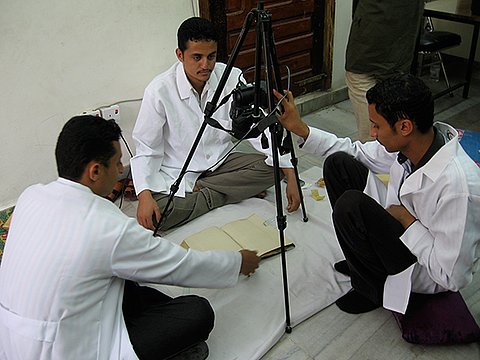
Despite the enormous significance of all these efforts, there are also several downsides. The Egyptians, and later the Kuwaitis, had a selective approach in their choice of manuscripts to be microfilmed (they were aiming particularly at the literary legacy of the Muʿtazilites, a theological movement with a rationalist approach that dominated Islamic doctrinal thought from the ninth through the thirteenth century). They managed to publish a fair amount of works they had brought from Yemen during the late 1960s and 1970s, and with this rendered a great service to scholarship. Moreover, the publication of these works evoked a reappraisal of rationalism as evidenced in the theological writings of the Muʿtazila, resulting in a movement that was summarized under the label Neo-Muʿtazila. The Iranians, who microfilmed and later digitized significant amounts of Yemeni manuscripts during the early 2000s, had a far more comprehensive approach—in many cases they filmed entire collections. The various digitization efforts supported by the German Foreign Office8 and the Deutsche Forschungsgemeinschaft in conjunction with the National Endowment for the Humanities9 —both carried out in cooperation with the Imam Zayd bin Ali Cultural Foundation—aimed at digitizing a select number of private collections in their entirety.
The handlists that were produced for the digitized materials often omit the whereabouts of the original manuscripts, which is a major hurdle for the accurate scholarly usage of the material and subsequent scholarly communication about the manuscripts, as well as for future efforts to digitize additional private collections. Generally, the cataloguing of the holdings of the libraries of Yemen, especially the private ones, is in a very poor state and their history has not been studied up until now. Moreover, as a result of the political vicissitudes of Yemen during the twentieth and twenty-first centuries, and the fact that most private libraries are in family ownership, those libraries are subject to constant change, and it is often unclear whether a library, quoted for example in a handlist created by Egyptian scholars in the 1960s, still exists, and, if so, under which name.
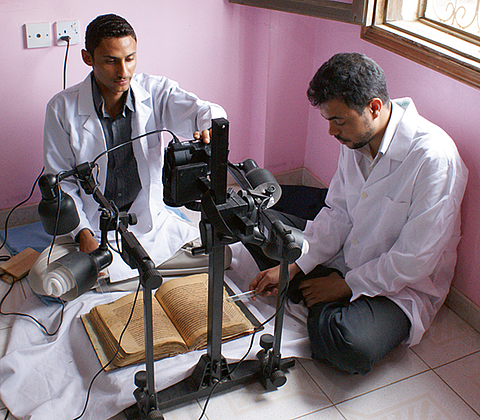
While scholars outside of Yemen are able to access only a fraction of the relevant manuscript materials housed by Yemeni libraries, scholars of Yemen are for all practical purposes unable to consult any of the Zaydi manuscripts housed by European or North American libraries—the costs for digital images render them unaffordable, and only a fraction of the close to eleven thousand manuscripts have so far been digitized.
The Zaydi Manuscript Tradition: A Digital Portal
The most recent initiative to preserve the Zaydi manuscript culture and to democratize access to it is "The Zaydi Manuscript Tradition (ZMT): A Digital Portal,” a joint project initiated by the Institute for Advanced Study in partnership with the Hill Museum & Manuscript Library (HMML) in Minnesota. It consists of two components: a digital portal, which is housed on the website of the Institute for Advanced Study,10 and HMML's virtual reading room, vHMML, which serves as the repository of digital surrogates of manuscript codices.11
The purpose of the ZMT is threefold. Through its digital portal, it serves as a comprehensive research guide to relevant collections of Zaydi manuscripts, providing precise information on the location of each collection with a full list of its holdings (shelf marks) and the relevant bibliography for every single codex. Each entry is linked to a corresponding entry in the virtual reading room of the Hill Museum & Manuscript Library. This provides a stable HMML Project Number and permanent link for each manuscript. In a second phase of the project, full metadata will be produced for the manuscripts included in the project using the vHMML reading room’s cataloging tools.
In addition to this, the digital portal functions as a gateway to manuscripts within the confines of the ZMT that have already been digitized. Provided a repository has uploaded digital images of its own holdings, the portal links the user directly to those repositories. Images of holdings of other collections of Zaydi manuscripts, to the extent that these are available or can be produced, will be uploaded to the digital reading room of vHMML, and links to the respective digital codices are again provided through the portal.
The project, which aims to provide open access to an estimated fifteen thousand digitized manuscripts over the course of the next three years, will help to salvage the rich Yemeni heritage, which is on the verge of destruction. These measures will also effectively democratize access to the Zaydi Manuscript Tradition, which is expected to result in an upsurge of this important field of study and will serve as a model for other fields within Islamic studies where scholars face similar challenges. At the same time, the ZMT project will help to bring more of the enormous richness and intellectual diversity of Islamic culture to the forefront and make it accessible for everyone.
Most importantly perhaps, the preservation and dissemination of the mostly unknown Zaydi theological and legal literature will underscore the fact that a rationalist epistemology continued in Islamic thought for a longer period than is generally recognized. The preservation, dissemination, and study of these rich manuscript materials will thus not only have an immediate impact on several fields of scholarship in the humanities but also bring the rational heritage of Islam to the forefront and thus contribute to a more nuanced picture of the Islamic intellectual tradition and culture among Western observers.
Recommended Reading:
“Institute for Advanced Study Partners with Hill Museum & Manuscript Library to Share Threatened Manuscripts from Yemen and Neighboring Countries,” Hill Museum & Manuscript Library, April 11, 2017, http://bit.ly/2oHjzB9
1 It is mostly thanks to the courageous attempts of the people of Timbuktu that most of the manuscripts were saved and clandestinely smuggled out to Bamako. They are currently being preserved through digitization, with generous support by various international funding agencies and private donors, under the aegis of the Hill Museum & Manuscript Library (HMML) https://goo.gl/v7hGEd.
2 Cf. Muna Fadhil, "ISIS Destroys Thousands of Books and Manuscripts in Mosul Libraries," The Guardian (February 26, 2015) https://goo.gl/xNCzZZ; Henri Neuendorf, "8,000 Books Burned by ISIS in Massive Iraqi Libricide," Artnet News (February 25, 2015) https://goo.gl/anUEJj.
3 For cases of looting and destruction between 2014 and 2016, see David Hollenberg and Anne Regourd, "Manuscript Destruction and Looting in Yemen: A Status Report," Chroniques du manuscrit au Yémen 21 (2016): 157–177.
4 Maxim Romanov, "Chronological Coverage of an Arabic Corpus: An Experiment with Data Statements" https://alraqmiyyat.github.io/2016/03-29.html.
5 See, e.g., the contributions to The Neglected Šīʿites: Studies in the Legal and Intellectual History of the Zaydīs, ed. Sabine Schmidtke = Arabica: Journal of Arabic and Islamic Studies 59/3-4 (2012) and The Yemeni Manuscript Tradition, ed. David Hollenberg, Christoph Rauch, and Sabine Schmidtke (Leiden: Brill, 2015).
6 See, e.g., the obituary by Adel al-Aulaqi at http://al-bab.com/albab-orig/albab/bys/obits/alakwa.htm.
7 See also the references to the relevant primary and secondary sources included in the Zotero Group Library "Zaydi Studies" at www.zotero.org/groups/zaydi_studies, which is an ongoing project.
8 “Preserving Yemen’s Cultural Heritage: The Yemen Manuscript Digitization Project" (YMDP), 2010. See Sabine Schmidtke and Jan Thiele, "Preserving Yemen's Cultural Heritage: The Yemen Manuscript Digitization Project," Fair Observer (2011) www.fairobserver.com/region/middle_east_north_africa/preserving-yemens-cultural-heritage-yemen-manuscript-digitization-project/
9 “The Yemen Manuscript Digitization Initiative” (YMDI), 2010 through 2013, https://ymdi.uoregon.edu
10 www.ias.edu/digital-scholarship/zaydi_manuscript_tradition
